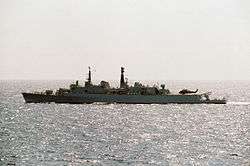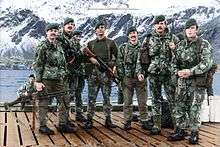Operation Paraquet
| Operation Paraquet | |||||||
|---|---|---|---|---|---|---|---|
| Part of the Falklands War | |||||||
| |||||||
| Belligerents | |||||||
|
|
| ||||||
| Commanders and leaders | |||||||
| John Fieldhouse | Luis Lagos | ||||||
| Casualties and losses | |||||||
| 2 helicopters crashed |
1 killed 1 submarine lost | ||||||

Operation Paraquet was the code name for the British military operation to recapture the island of South Georgia from Argentine military control in April 1982 at the start of the Falklands War.
The official name "Paraquet" is an alternative spelling of Parakeet, but the operation is perhaps more widely known as Operation Paraquat, an unofficial name adopted by troops in the South Atlantic who feared the operation would prove as lethal to them as the weedkiller Paraquat. This view prompted the expression "Kill Paraquat before it kills us."
The operation, a subsidiary of the main Operation Corporate (recapture of the Falkland Islands from Argentina) was successful, leading to the island being restored to British control on 25 April 1982.
Background
Concept
Prompted by the British war cabinet who needed a demonstration of political resolve, the operation was ordered by Admiral John Fieldhouse at Northwood Headquarters and planned by staff at 3 Commando Brigade. Major General Jeremy Moore of the Royal Marines was told to provide a Commando company group for a secret mission. Originally selecting 45 Commando who had recently completed jungle warfare training, the final selection was 42 Commando who had recently been on a winter deployment to Norway. The second-in-command of 42 Commando, Major Guy Sheridan, an experienced mountaineer, was selected to be Landing Force Commander. M Company of 42 Commando, commanded by Captain Chris Nunn, was augmented by specialists from the Reconnaissance Troop, the Support Company, signals and medics; a total of 132 men.[1] Sheridan requested the support of the Royal Marine Mountain and Arctic Warfare Cadre, but was instead given 19 (Mountain) Troop from D Squadron Special Air Service (SAS) from Ascension Island. In the event, the whole of D Squadron comprising not only the Mountain Troop, but also 16 (Mobility) Troop, 18 (Air) Troop and 17 (Boat) Troop along with the Squadron HQ all joined the force at Ascension. Finally, 2 Troop, Special Boat Squadron (2 SBS) and, as requested by Sheridan, two Naval Gunfire Forward Observation Parties (NGFOs) also joined the task group.[2]
The addition of the extra troops caused some difficulty in the already crowded accommodation in the available ships. The task group sailed from Ascension on 11 April, pausing to redistribute the SAS troops between ships on the 13 April. The final disposition was that M Company were on the tanker Tidespring, 2 SBS, and the Mountain and Boat Troops SAS on the frigate, HMS Plymouth, with the rest of D Squadron on the destroyer HMS Antrim.[2] Finally, 6 SBS were embarked in the submarine HMS Conqueror. This group, known as CTG 317.9, was commanded by Captain Brian Young of the Antrim.[3][4]
The task group met with HMS Endurance on 14 April and on the following day, received written orders (dropped by an RAF Nimrod aircraft) for the operation from Admiral Fieldhouse dated 12 April and giving a landing date of 21 April.[2]
Reconnaissance phase
Conqueror was first on the scene and carried out a survey of key areas of the South Georgia coast.[5] The operation was originally supposed to involve both SAS and Special Boat Service (SBS) forces being infiltrated onto South Georgia by helicopters from the Tidespring and Antrim, but the plan had to be changed when the two Wessex helicopters transporting the SAS troops from an ambitious location on the northeast coast crashed in bad weather on Fortuna Glacier; the troops and aircrew were rescued by Antrim's Wessex helicopter, the last Wessex remaining to the expedition.[5]
Argentine reinforcements aboard Santa Fe
The Argentine submarine forces consisted of four boats. Two were modern type 209 submarines and two were GUPPY conversions of United States World War II fleet submarines. One of the latter, ARA Santa Fe, was the only submarine to see combat during the conflict. Her sensors were unreliable, and the charge capacity of her aged batteries was much reduced from their original design. Santa Fe transported troops while under orders to remain undetected, not to attack any ships, and to break contact with any ship which might detect her.[6]
On 9 April the Santa Fe left port in Argentina with eleven technicians to restore utility services on New Georgia and nine marines with Bantam anti-tank missiles to reinforce the original invading force armed only with rifles and machine-guns. Storm conditions prevented use of the snorkel, which placed unexpected demands on the batteries, and required remaining surfaced during part of the approach. The reinforcements were successfully landed at Grytviken under moonless cloud cover in the pre-dawn hours of 25 April. Santa Fe was underway by 05:00, but was discovered by Antrim's Wessex helicopter before she could submerge. The Wessex was joined by task force Wasp and Lynx helicopters, which fired at least six AS-12 missiles at the submarine. Santa Fe returned to Grytviken in sinking condition while her crew fired at the helicopters with rifles.[6]
Execution
There followed a helicopter[7] assault by an improvised group of Special Forces and Royal Marines, with two Royal Navy vessels (Antrim and Plymouth) conducting a naval bombardment demonstration on the low hills opposite Grytviken. The garrison at Grytviken and the crew of the disabled Santa Fe surrendered to M Company, 42 Commando, Royal Marines, after fifteen minutes at 17.15 GMT, although the garrison at Leith Harbour, under the command of Lieutenant Commander Alfredo Astiz, surrendered the following day.[5] Sweden and France requested Astiz's extradition from the British authorities after learning about his capture, but his captors rejected the petition.[8]

An Argentine prisoner of war, Navy Petty Officer Felix Artuso, a crewman of the Santa Fe, was mistakenly shot dead on 26 April after a British marine thought he was sabotaging the submarine. He is buried at Grytviken Cemetery.[9][10]
A message that was widely publicised in Britain was made by the Task Group Commander, Captain Brian Young, after the surrender at Grytviken:[11]
- Be pleased to inform Her Majesty that the White Ensign flies alongside the Union Jack in South Georgia. God save the Queen.[7]
Wildlife film maker Cindy Buxton and her assistant Annie Price, who had been filming in an isolated part of the island before the invasion, were evacuated by a helicopter from HMS Endurance on 30 April.[12]
References
- ↑ Van Der Bijl, Nick (2007). Victory in the Falklands. Pen & Sword Military. p. 44-45. ISBN 978-1844154944.
- 1 2 3 Van Der Bijl p. 47
- ↑ http://www.telegraph.co.uk/news/obituaries/military-obituaries/naval-obituaries/6975842/Captain-Brian-Young.html
- ↑ http://www.britains-smallwars.com/Falklands/Operation-Paraquat.html
- 1 2 3 "Sink the Belgrano", Mike Rossiter, 2007, Transworld, London, pp 189-233
- 1 2 Scheina, Robert L. (1984). "Where Were Those Argentine Sibs?". Proceedings. United States Naval Institute. 110 (3): 115–120.
- 1 2 "Remarks on the recapture of South Georgia", Margaret Thatcher Foundation
- ↑ Méndez, Juan E. (1991). Truth and partial justice in Argentina: an update. Human Rights Watch, p. 32. ISBN 0-929692-91-8
- ↑ Marine killed Argentinian in Falklands war blunder
- ↑ Félix Artuso's grave
- ↑ http://www.telegraph.co.uk/news/obituaries/military-obituaries/naval-obituaries/6975842/Captain-Brian-Young.html
- ↑ Buxton, Cindy; Annie Price (1983). Survival South Atlantic. London :: Granada,. pp. xiii,237p.,[64]p. of plates : ill(some col.), maps,col.ports. ; 26cm. ISBN 0-246-12087-8.
External links
- Naval-History.Net - "Battle Atlas of the Falklands War 1982" by Gordon Smith
- The RAF - "The Falkland Islands - A history of the 1982 conflict"
- "The Official History of the Falklands Campaign"
- "Sea Control 74: Falklands Series 5 – South Georgia OPS" (Podcast). Center for International Maritime Security. 13 April 2015.